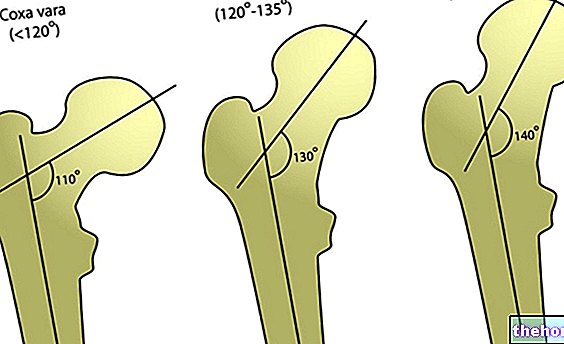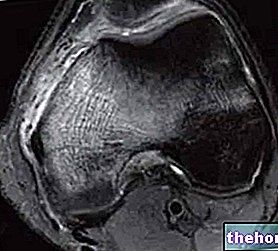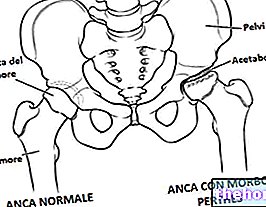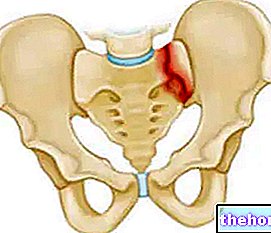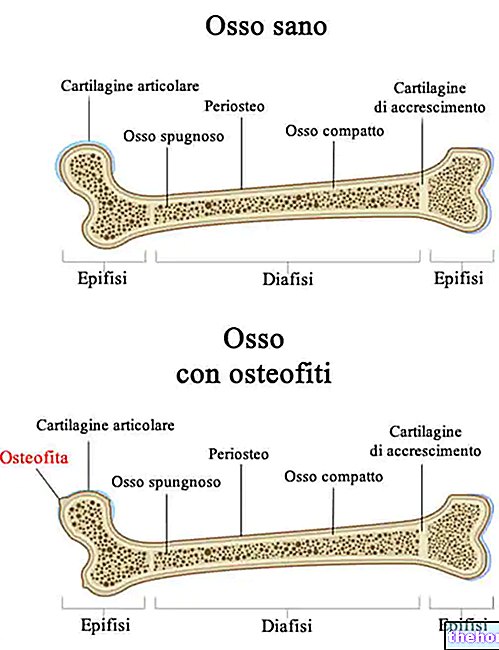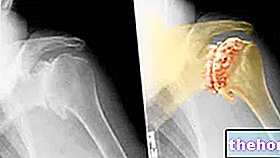Generality
An "arthritis is any inflammatory condition that involves one or more joints.

There are numerous types (or forms) of arthritis. The causes that induce its appearance can be traumatic, metabolic, infectious, autoimmune or idiopathic.
The best known and most widespread forms of arthritis are osteoarthritis and rheumatoid arthritis.
However, we must not forget the existence of gout, psoriatic arthritis, ankylosing spondylitis, cervical spondylosis, systemic lupus erythematosus, enteropathic arthritis, etc.
What is arthritis?
Arthritis is the medical term for the presence of an "inflammation affecting one or more joints.
There are several types (or forms) of arthritis, each with its own unique causes and characteristics.
EPIDEMIOLOGY
Arthritis is a fairly common inflammatory condition.
According to some statistical studies, in the United Kingdom there are about 10 million people suffering from arthritis, out of a total population of about 64 million inhabitants.
Similar statistical studies, however, referring to the United States, report that the number of Americans with arthritis is about 52 million, out of a total of almost 319 million inhabitants.
Comparing the two situations shows that the incidence of arthritis in the United Kingdom and the United States is very similar.
Arthritis affects people of all ages, including children (juvenile arthritis).
Some epidemiological curiosities:
- In the United States, one in five adults suffers from a known form of arthritis.
- Between 2010 and 2012, in the United States, 49.7% of adults over the age of 65 suffered from a known form of arthritis.
- By 2030, some US experts estimate that, in the United States, there will be approximately 67 million people aged 18 and over with a form of arthritis.
- In the United States, the number of people under 18 with one type of arthritis is approximately 294,000, or nearly one in every 250 young people.
BRIEF ANATOMICAL RECALL OF A TYPICAL JOINT
Joints are anatomical structures, sometimes complex, which put two or more bones into mutual contact.
In the human body, there are about 360 of them and their job is to keep the various bone segments together, so that the skeleton can fulfill its function of support, mobility and protection.
Anatomists divide joints into three main categories:
- Fibrous joints (or synarthrosis), lacking in mobility and whose bones are joined by fibrous tissue. Examples of this are the bones of the skull.
- Cartilaginous joints (or amphiarthrosis), with poor mobility and whose bones are linked by cartilage. Classic examples of amphiarthrosis are the vertebrae of the spinal column.
- The synovial joints (or diarthrosis), which thanks to their particular conformation are extremely mobile. Elements such as: the articular surfaces (parts of the bones involved in diarthrosis), the joint capsule, the joint cavity, the hyaline cartilage layer that covers the joint surfaces, the synovial membrane (or synovium) and a series of ligaments contribute to the particular conformation and tendons.
The best known diarthrosis are the knee, shoulder or ankle joints.
Symptoms
For further information: Arthritis Symptoms
Most of the symptoms and signs of "arthritis involve the joints of the human body.
Typical manifestations of "joint inflammation are:
- Ache
- Joint stiffness
- Joint swelling
- Redness and a sense of warmth
- Reduced range of motion
There are forms of arthritis that also affect non-articular anatomical regions, such as the layers of the skin, the eyes, the respiratory system or the lympho-glandular system.
Causes
Causes of arthritis can be of traumatic, metabolic, infectious, autoimmune, and idiopathic origin.
The typing of the various existing arthritis depends on the origin of the causes.
Types
There are numerous types of arthritis, some more common than others.
The best known and most common forms of arthritis are, without a doubt, the so-called osteoarthritis and the so-called rheumatoid arthritis.
Among the less common forms of arthritis, the following deserve a mention: ankylosing spondylitis, cervical spondylosis, fibromyalgia, systemic lupus erythematosus, gout, psoriatic arthritis, enteropathic arthritis, reactive arthritis, secondary arthritis and polymyalgia rheumatica.
Juvenile types of arthritis, that is, inflammatory conditions of the joints that specifically affect young people, represent a separate category.
OSTEOARTHRITIS
Osteoarthritis, also known as osteoarthritis, is the most common type of arthritis of all.
The inflammatory state that characterizes it arises as a result of a progressive deterioration of the cartilage layer that covers the joint surfaces.
The risk factors for osteoarthritis are different, the most important being advanced age, female sex, joint injuries and obesity.
Osteoarthritis can affect any joint; however, it has a predilection for the joints of the hand, knees, hips and joints in the spine.
In addition to pain, joint stiffness, swelling and reduced range of motion, it also leads to the formation of osteophytes (or bone spurs).
At an advanced stage, osteoarthritis makes it very difficult to use the joints affected by the inflammatory state. For example, if you hit your hands, even a simple "activity like writing can be difficult to perform."
Unfortunately, there are no specific treatments for osteoarthritis; there are only symptomatic treatments, that is, aimed at reducing the symptoms in progress.
For therapeutic (to improve symptoms) and preventive purposes, doctors recommend keeping active and practicing constant physical exercise.
RHEUMATOID ARTHRITIS
Rheumatoid arthritis is an autoimmune disease, which is a morbid condition that arises as a result of a malfunction of the immune system.
Various studies have shown that rheumatoid arthritis has various risk factors; among these, the most important are: the genetic-familial predisposition (obviously to rheumatoid arthritis), belonging to the female sex, the age between 40 and 60 years old, smoking tobacco and coming into contact with some pathogens (in particular herpes virus and Epstein Barr virus).
Unlike osteoarthritis (which attacks joint cartilage), rheumatoid arthritis attacks the joints at the level of the synovial membrane. Of a progressive nature, the aggression against the synovial membrane induces, in turn, an "alteration of the entire joint structure, with the articular surfaces and the articular cartilage that are damaged, with the ligaments that weaken and stretch." and with the joint capsule changing shape.
In the early stages of rheumatoid arthritis, inflammation mainly affects the joints of the fingers and toes. In a more advanced stage, it also affects the wrist joints, knees, ankles, hips and shoulder joints.
At the non-joint level, inflammation can involve the skin, the lympho-glandular system, the respiratory system and the eyes.
In addition to the classic symptoms of arthritis, the rheumatoid form can also cause fever, weight loss and muscle wasting.
Often, the condition alternates between phases characterized by "intense symptomatology and phases of apparent remission."
Similarly to the case of osteoarthritis, rheumatoid arthritis is incurable and the only existing treatments against it consist of symptomatic treatments, aimed at improving symptoms and slowing down joint degeneration.
ANKYLOSING SPONDYLITIS
Ankylosing spondylitis is a form of chronic and degenerative arthritis, also of autoimmune origin.
This condition mainly determines the fusion of the articular elements of the spine and affects the proper functioning of tendons and ligaments in several parts of the body (especially in the back).
Due to the fusion of the articular elements of the vertebral column, the latter loses flexibility and compromises the patient's postural structure.
The precise causes of ankylosing spondylitis are still unclear. According to the most accredited causal theories, it would have a "genetic origin and a particularly important gene in the development of the disease would be HLA-B27.
At an advanced stage, ankylosing spondylitis also affects other areas of the human body, including: the eyes (causes an "eye inflammation known as uveitis), the aorta (changes its shape) and the heart (alters the morphology of the valve. aortic).
There is no specific cure for ankylosing spondylitis. The only treatments available are symptomatic and are aimed at delaying the onset of complications.
CERVICAL SPONDYLOSIS
Cervical spondylosis is a degenerative morbid condition that affects the spine, in this case the cervical spine. Affecting the latter, it determines a form of arthritis that induces the slow but progressive deformation of the vertebral bodies and intervertebral discs.
The precise causes of cervical spondylosis are unknown. However, the researchers agree that the onset of the condition is due to a number of factors, including: a certain genetic-familial predisposition, repeated stress and trauma to the cervical spine, heavy work, strain, surgery to remove hernias. disc etc.
According to the clinical data in possession, cervical spondylosis is particularly widespread in the population over the age of 60; therefore it is probably a disorder also linked to old age.
Lacking a specific cure for cervical spondylosis, the therapeutic goal of the treatments available today is to improve symptoms (reduce pain, prevent permanent spinal injuries, etc.).
SYSTEMIC LUPUS erythematous
Systemic lupus erythematosus (SLE) is a chronic inflammatory disease of autoimmune and multisystem origin.
Multisystem means that it affects different organs and tissues of the body. These tissues also include the anatomical structures that make up the joints.
Although the exact causes have not yet been identified, the researchers believe that SLE occurs as a result of a combination of genetic, hormonal and environmental factors.
To learn about the treatment of systemic lupus erythematosus, readers can click here.
GOUT
Gout is a metabolic disorder that causes:
- Elevated serum urate levels (hyperuricaemia)
- Formation of uric acid deposits in various locations of the human body (tophi)
- Inflammatory states affecting the joints, with deposits of urates in the cartilages (gouty arthritis)
- Kidney disease
Definitely more common in men, gout causes intermittent pain, swelling, erythema and heat in the joints.
The joints most affected are those of the hands and feet: by far, the most affected site is the metatarsophalangeal joint of the big toe.
Gout is treatable: There are treatments for both gout attacks and to prevent future attacks.
To learn more about gout therapy, readers can consult the article here.
FIBROMIALGIA
Fibromyalgia is a rheumatic condition that affects the musculoskeletal system.
As you can guess from its name, it causes pain in the muscles and fibrous tissues, which in this case are the tendons and joint ligaments.
From a symptomatic point of view, fibromyalgia determines:
- A chronic and widespread painful sensation
- Increased muscle tension
- Stiffness in numerous locations of the locomotor system
The precise causes of fibromyalgia are unclear; at the moment, doctors suspect that this condition has a multifactorial origin (genetic, neurochemical, environmental, hormonal, psychological factors, etc.).
Currently, fibromyalgia is only treatable in symptoms.
ENTEROPATHIC ARTHRITIS
Enteropathic arthritis is a type of chronic arthritis typically associated with two chronic inflammatory bowel diseases: Crohn's disease and ulcerative colitis (or ulcerative colitis).
It mainly affects the joints of the extremities of the human body and the joints of the spine.
The causes of enteropathic arthritis are still unclear. According to the researchers, in some cases the genetic-family predisposition plays a decisive role.
Currently, enteropathic arthritis is treatable only in its symptoms.
REACTIVE ARTHRITIS
Reactive arthritis is a type of arthritis with a double origin: infectious and autoimmune.
According to various scientific studies, the microorganisms involved in the development of this joint inflammation are: chlamydia, salmonella, shigella, yersinia and campylobacter, all bacterial pathogens.
In addition to the joints, reactive arthritis can also affect the eyes and urethra, causing conjunctivitis and urethritis, respectively.
When reactive arthritis also affects the eyes and urethra, it takes the more correct name of Reiter's syndrome. Palliative medications are available for treatment.
RHEUMATIC POLYMALAGIA
Polymyalgia rheumatica is an "inflammation of the muscles, which starts from the shoulders, neck and hips, and then spreads to the rest of the body and also affects the joints.
After all, muscles and joints are interconnected and, very often, the state of health of the former depends on the state of health of the latter.
The causes of polymyalgia rheumatica are currently unknown; according to the most reliable hypotheses, at the origin of the condition there would be a combination of genetic and environmental factors.
The main treatment for polymyalgia rheumatica consists in the administration of corticosteroids, very powerful and effective anti-inflammatory drugs, but also with numerous side effects.
PSORIASIC ARTHRITIS
Psoriatic arthritis is a type of arthritis that people with a medical condition known as psoriasis develop.
Psoriasis is a chronic, relapsing, non-contagious inflammatory skin disease that arises as a result of "hyperproliferation of epidermal keratinocytes and causes the formation of reddish patches / plaques, especially on the knees, elbows, hands, scalp and feet.
Psoriatic arthritis - like psoriasis - most likely has an autoimmune origin.
It can affect any joint in the human body; however, it predominantly affects the joint elements of the hands, feet, knees, elbows, neck and spine.
SECONDARY ARTHRITIS
Secondary arthritis is a type of arthritis that arises as a result of repeated injury to a joint or pair of joints (eg two knees, two shoulders, etc.).
Generally, it appears several years after injuries.
YOUTH FORMS
The most prominent forms of juvenile arthritis fall under the broad category known as juvenile idiopathic arthritis (JIA).
In medicine, the term idiopathic / idiopathic, associated with the name of a pathology, indicates that the latter has arisen for unknown or unidentifiable reasons.
Returning therefore to the forms of juvenile arthritis of the JIA, these conditions are:
- Juvenile oligoarticular arthritis (or oligoarticular JIA or oligoarticular JIA): is the most common form of JIA and affects less than 5 joints. In most cases, the joint elements affected are the knees, ankles and wrists.
Prognosis is generally good and long-term effects are rare. However, it should be noted that some patients also develop eye problems. - Polyarticular JIA: this form of juvenile arthritis affects more than 5 joints and resembles rheumatoid arthritis symptomatically.
Often, the onset of polyarticular JIA is followed by the onset of rash skin and fever. - Systemic JIA: this juvenile arthritis initially causes fever, rash cutaneous and lethargy; only later do joint problems arise (swelling, pain, etc.).
- JIA associated with enthesitis (or arthritis with enthesitis): is a form of juvenile arthritis that causes pain in the feet, knees and hips.

